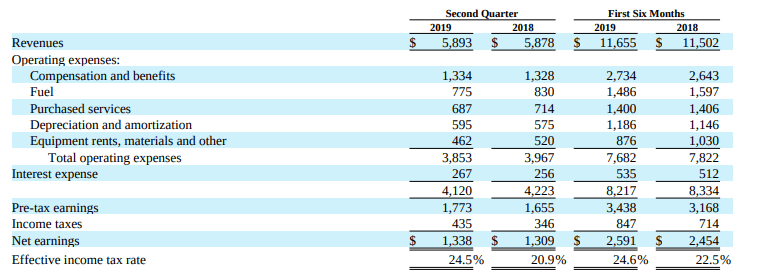Second-quarter revenue for BNSF, a unit of Berkshire Hathaway (NYSE: BRK), rose 0.3 percent despite lower volumes for agricultural products, consumer products and industrial products, the railroad’s parent company said on August 3.
BRK said BNSF’s second-quarter revenues totaled $5.9 billion, a 0.3 percent increase from the second quarter of 2018, while operating expenses fell 2.9 percent to $3.9 billion. Net profit was $1.34 billion in the second quarter, up 2.3 percent from $1.31 billion for the same period last year.
Revenue for the first six months of the year was $11.7 billion, a 1.3 percent increase from the same period a year ago. On a revenue per car basis, revenue for the first half of the year was up 6.3 percent. But rail volumes fell by 4.5 percent to 5.0 million cars for the first half of the year as severe winter weather and flooding impacted parts of BNSF’s network.
Total operating expenses for the first six months of the year were 1.8 percent lower at $7.7 billion. Net earnings were $2.59 billion, a 5.6 percent increase from $2.45 billion for the first six months of 2018.

In the second quarter and the first half of the year, bad weather, a tight truck market and trade market uncertainty were among the factors leading to lower rail volumes. But some of BNSF’s segments managed to increase their revenues despite the headwinds.
Industrial products’ revenue rose 6.4 percent to $1.6 billion in the second quarter and it increased 7.4 percent to $3 billion in the second half of the year amid higher average revenue per car. BNSF saw higher demand to transport petroleum products and liquefied petroleum gas, which offset lower fracking sand volumes and reduced car loadings because of bad weather.
Agricultural products’ revenue in the second quarter increased by 3.3 percent to $1.2 billion amid a higher revenue per car. But agricultural volumes fell 4.2 percent amid export competition from other countries, trade policy and challenging weather conditions, BRK said. These factors also influenced lower agricultural products’ volumes for the first half of the year. Agricultural products’ revenue for the first two quarters of 2019 totaled $2.3 billion, which was flat with the same period in 2018.
Consumer products’ volumes fell 3.8 percent in the second quarter to $1.9 billion but were up 1.7 percent to $3.9 billion for the first half of the year. Both periods witnessed higher average revenue per car despite a 6.3 percent drop in volumes in the second quarter and a 6 percent drop for the first half of the year. Reduced consumer demand, higher truck capacity, a lower international intermodal market share and a decrease in imports were the factors contributing to the drops in consumer products’ volumes.
Coal revenue fell 3.1 percent to $883 million in the second quarter although coal volumes rose 1.1 percent on increased customer demand. For the first six months of the year, coal revenue was down 5.8 percent to $1.8 billion as adverse weather conditions contributed to a 4.8 percent drop in volumes.







